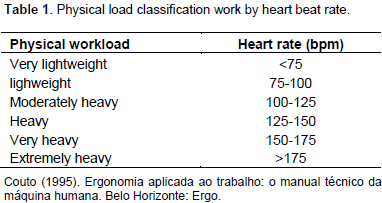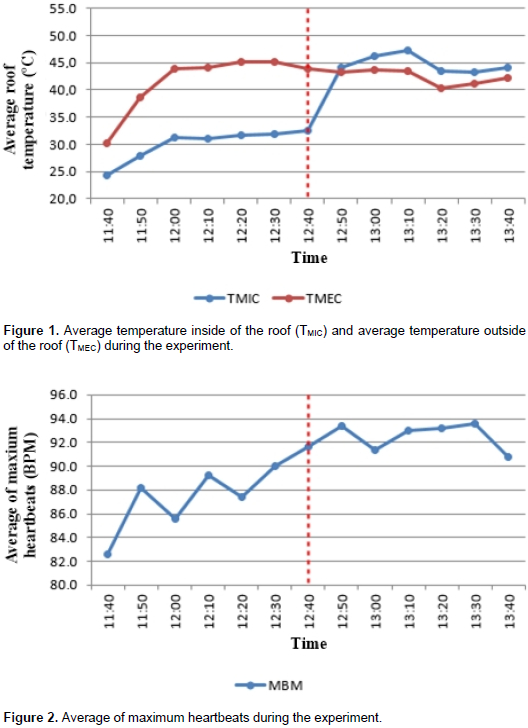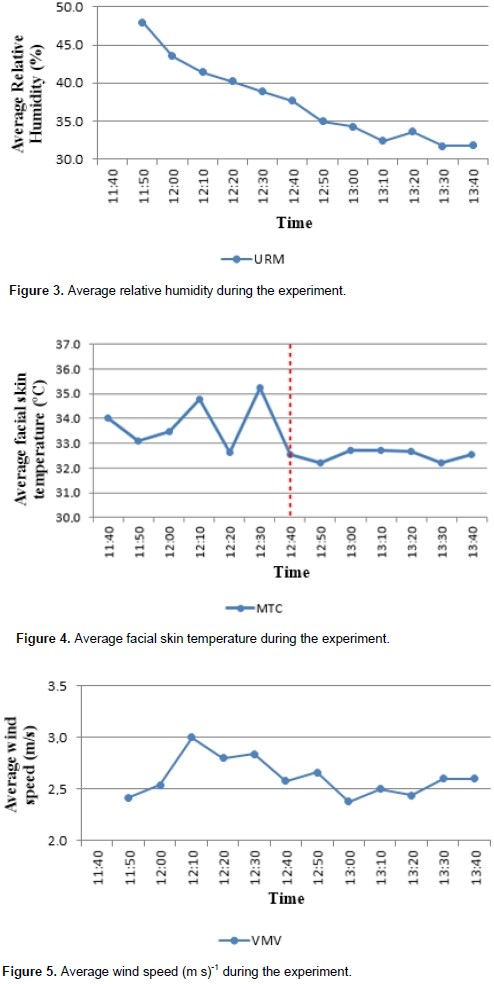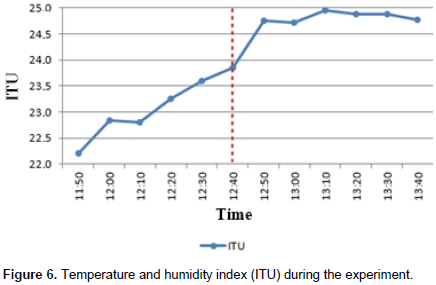ABSTRACT
Heat stress appears as a strong candidate for physical wear and tear, leading to lower yields and high risks of accidents due to lack of attention. In this context, this work aims to study the possible influence of the internal temperature of metal roof tractor, skin temperature of face operator, relating it to possible physiological responses connected with environmental variables such as relative humidity air and wind speed. An insulating composite panel based on residual materials (cement bag) was prepared and placed under the tractor roof for thermal isolation purpose. The tractor used in the experiments is manufactured in 1997, with engine power of 173 hp at 2200 rpm; it works for 8200 h and has original factory roof. The experiment was carried out in the open field for five days, following the same start time (11 h 40 min) and ending time (13 h 40 min); it corresponds with the maximum sun intensity, where in the first hour there was panel and after 12 h 40 min, there was no panel. After analyzing the data, there was a reduction in the average temperature inside the cabin with the presence of the insulating panel. The physical workload, based on heart rate, remained in "light" range, even with no physical requirements for the operator. Regarding the average temperature facial skin, it showed an increase of 1.1°C after the panel removal. According to the classification of temperature level and humidity, despite a steady increase in value during the 2 h of the experiment, the index remained in the position of little discomfort. Based on the data, it is clear that simple measures can be taken to improve the thermal environment in tractors with roof control platform, in addition to stimulating the study for improving cooling in tractor cabin.
Key words: Instrumentation, sustainability, welfare, agribusiness.
A major difficulty faced by operators of agricultural machinery in hot environment is the harsh working conditions which can cause great discomfort and low income. According to Jay and Kanye (2010), a high exposure time, combined with variations in temperature and humidity in the workplace can put workers at risk. Actually, even with all the ergonomic evolution, targeting the security and welfare of the operator, agricultural tractors in circulation in the country, for most part, present problems of comfort and safety for operators (Santos et al., 2010). According to Costa (2012), environmental risks are classified as physical, chemical and biological hazards. The authors comment on the importance of studying the problems caused by heat stress, for example heat rash,heat cramps, heat exhaustion and heat stroke. Although there are tractors with acclimatized cabs, most of the fleet of the small and medium properties is composed of tractors that have only roofs; these may be of different materials. The use of roofs to avoid direct contact with heat is not enough to protect the operators from exposure to high temperature; it may lead to, according to Leite (2002), the same health problems, interfering with productivity and increase possibility of occurrence of errors that can lead to accidents. Today, with the advancement in safety standards at work, there is a search for better conditions of ergonomics and operator safety, significantly reducing the incidence of illness linked to the steady work (Alves et al., 2011). Thus, it becomes more significant for the development of agricultural machine. However, recent studies point to the need for improvement and development in the ergonomic design of agricultural tractors (Baesso et al., 2014).
The human thermoregulation is essential for the maintenance of the physiological responses of production, absorption and heat loss. During exercise or even at rest, the human body needs instruments for achieving homeostasis and to ensure temperature of about 37.0°C, to avoid hyperthermia and hypothermia (Costa, 2012). Heat exchange between the human body and environment is done by an organic system called thermoregulation (Sousa, 2014). The surface skin temperature and heart rate can act as important indicators for checking the thermal stress in machine operators. Therefore, instruments used for measuring chemical temperature and different types of contact thermal sensors have been used (Lim et al., 2008). However, this type of specific measure directly on the skin can infer misinterpretations, since heating does not occur uniformly on the skin (Vainer, 2005; Sousa, 2014). Thus, it is necessary to use a more appropriate method for measuring the surface temperature of the skin, such as the use of thermographic camera. The use of infrared thermographic camera is considered, a non-destructive character of technical and non-invasive, since it does not have direct contact with the analyzed surface. The image is constituted from thermal infrared radiation emitted by different surface materials (Castanedo, 2005; Maldague, 2001; Tavares, 2006). From these studies, it is feasible to do a comprehensive assessment of some factors that can influence the thermal comfort of the operator tractors with metal cowling and may modify the conditions to which it is exposed through simple measures, such as the coupling of a panel composed of recycled materials.
The experiment was conducted at the Faculty of Animal Science and Food Engineering (FZEA), University of São Paulo (USP), Campus Fernando Costa, Pirassununga. The campus geographical location is latitude 21° 59'S and longitude 47° 26'W; it has an average height of 634 m. The climate is subtropical, Cwa, with dry winter and hot and rainy summer, according to Köppen classification (Oliveira and Prado, 1984). For uniformity of data, the study area remained the same throughout the experiment; it was strategically chosen: it is an open area without trees and buildings that can cause shadows. A tractor, manufactured in 1997, with engine power of 173 hp at 2200 rpm, was used; it works for 8200 h. The structural component of the control stage (the area where the tractor driver operates) follows the factory originality even though it is a machine already widely used. A TESTO thermographic camera model 875-2 as well as their respective software, TESTO IRSoft version 3.7 was used to evaluate the temperature of human skin. Air temperature, relative humidity and wind speed were taken by two portable thermo-hygro-anemometer model THAL-300. As proposed by Sousa (2014), experimental images were obtained at 10 min at a distance of 0.5 to 1.5 m in three different regions of interest: outer surface of the roof, inner surface of the roof and the facial skin surface operator. After the image acquisition, it was treated by the respective software, in order to obtain data concerning the average temperature and humidity in a specific area of interest. This delimitation was carried out carefully to exclude not interesting objects that could adversely influence the measurements. In addition to the thermal images, the software allows selection of Palette "moisture image", providing a moisture image captured area.
For comparative purposes and changes in the thermal environment under the metal hood, a thermal insulating material board between the head of the operator and the tractor hood (roof) was employed. This thermal insulating board was supplied from Buildings Laboratory and Ambience (CONSTRAMBI). Four boards were produced with recycling material of empty cement bags and milk cartons. The panels have a size of 50 cm × 50 cm × 1.5 cm. The four plates were fixed inside the hood together in a single module with the aid of an MDF (Medium Density Fibreboard) with dimensions of 1,00 × 1,30 m. To fill empty areas and further reduce the heat transfer, polystyrene was used and covered with aluminium foil. The acquisition rate for heart beat was given by a portable heart monitor DLK, model HRM-E001. The heart rate data were collected at intervals of 10 min for a period of 2 h of the experiment, thereby generating a database of 20 samples per experiment. Couto (1995) classified the physical workload in six levels, relating them to heart beats, as shown in Table 1. The ITU is defined, according to Costa et al. (2009), using Equation 1:

ITU = T †0.55 (1†UR) (T †14) (1)
where ITU is the temperature and humidity index, °C; T is the Air temperature, °C; and UR is the relative humidity in decimal fraction.
According to Costa et al. (2009), it is still possible to classify the comfort range according to the value of the ITU (Table 2). This study was done with one operator; he is 23 years, 1.83 m tall, weighs 96 kg, healthy with no smoking or alcohol addictions. The works have adequate potable water close to the work area. According to Sousa (2014), the following caution should be taken:
(1) Avoid any physical activity that could affect body temperature and blood flow on the recorded locations for at least 1 h before performing the operation;
(2) Avoid drinking alcohol, coffee or tea prior to operation;
(3) Avoid sun burning;
(4) Avoid smoking during the operation;
(5) Avoid using sunscreen and/or other cosmetics such as cream, gel or spray;
(6) Avoid exposure to very hot water and bathe before the operation;
(7) Avoid wearing tight clothes, avoiding any grip on the skin;
(8) Avoid wearing rings, earrings, bracelets and chains during operation;
(9) Avoid intercourse in the last 12 h;
(10) Avoid the use of drugs;
(11) Avoid eating 2 h before the experiment
The results were analyzed using simple linear regression, Pearson correlation coefficient and comparison of means by Tukey test at 5% probability.
The measured results are shown in graphics (Figures 1 to 6). Figures 1, 2, 4, and 6 show a red segmented vertical line oriented at 12 h and 40 min; in the first period (11 h 40 min to 12 h 40 min) the measurements were made with the panel attached but in the second period (12 h 40 min to 13 h 40 min), there was no panel. The average values of the indoor and outdoor roof temperatures are represented respectively by TMIC and TMEC abbreviations for the two stages of the study, which means, with and without the insulating panel in the 2 h experiment (from 11:40 to 13: 40 h) (Figure 1). At the beginning of the experiment (11:40 to 12:00) an increase in temperature on either side of the roof is as shown in Figure 1. This is because the first samples were collected at the beginning of exposure to the sun. Thus, from the moment when the tractor is placed in the experimental area, both temperatures rise and in 20 min, stabilization is achieved. From the point of stabilization at 12.00 to the panel subtraction point at 12 h/40 min, the temperature difference between the inner surface of the panel in relation to the outer surface of the roof was inferior (12.8°C). The last sampling performed with the panel was at 12 h and 40 min where an elevation of 10.8°C was found at an interval of 10 min prior to the next collection (12 h 50 min). At that moment, there is an inversion temperature of superiorities where TMIC becomes an average of 2.4°C higher than TMEC.



The panel showed good thermal insulation, as the average roof temperature was 31.62°C with the panel, rising to an average of 44.88°C without the same. It is also possible to check the heat reflection on the inner surface of the panel influencing the temperature outside the roof, since the average external temperature of the hood ranged from 44.4°C coupled with the panel to 42.58°C with the removal of the same. The panel can be considered to simulate a "greenhouse effect" with the metal tractor roof and interfered significantly in TMEC and TMIC, as shown in Table 3. The mean values of heart rate were determined based on the maximum rate in each data collection interval. The average data of heartbeats are as shown in Figure 2. It can be seen that before the start of the collections in full sun (11 h 40 min), the operator is in a range of 75 to 100 bpm, which is classified as "light work of physical load", keeping this category throughout the experiment. This result is normal, since no physical nature of activity that requires a significant change during the five experimental days has been established. Thus, the variation in heart rate may be limited to more functions connected exclusively to the thermoregulatory response. Beginning a review of the beats with the tractor at 10 min in the environment (11 h/50 min), it appears that the average rate before the panel removal was 88.67 bpm; it rises to 92.57 bpm after 12 h 40 min, leading to a significant change. Initially, there is an adjustment of the human thermoregulatory mechanism in relation to the environment in which the operator is inserted. Applying the method of Pearson correlation coefficients (Callegari-Jacques, 2003), there is a moderate positive linear correlation of 0.5 between the variables "average relative humidity" (Figure 3) and "average facial skin temperature" (Figure 4).

This correlation may indicate that there was a more effective face heat exchange because of sweat evaporation (Widmaier et al., 2006) in the period after the panel subtraction. In the initial period (11 h 50 min to 12 h 40 min), there was a near 10% reduction in relative humidity, with an average of 41.6% relative humidity (12 h 40 min to 13 h 40 min); there was less variation range, close to 6%, with an average of 33.1% relative humidity. Therefore, this heat exchange (skin - environment) may have occurred in higher intensity after the removal of the panel, because of the reduction of the relative humidity experienced during the experiment. This is due to the fact that the lower the relative humidity, the easier would be the evaporation of sweat; the higher the relative humidity, the more difficult would be the evaporation of sweat produced (McArdle et al., 1992) According to the data expressed in Figure 5, the average facial skin temperatures remained very close to that stipulated by Sousa (2014) (33.7°C). The skin temperature maintained at 33.6°C for the period with the panel and 32.5°C for the period without the panel indicate a significant difference. For the calculation of ITU using the method developed by Costa et al. (2009), it is important that the average wind speed does not exceed 3.0 ms-1. Thus, it becomes a feasible calculation using Equation 1, because as shown in Figure 6, all the averages remained in the range between 2.0 and 3.0 m s-1. The ITU was calculated based on the relative humidity in the control platform and the average air temperature.
These results are as shown in Figure 6, for all the periods collected. Before the data a short rise could be noticed in the respective index during the experiment, with a stabilization in an average range of 24.85 after the removal of the panel. It is important to note that the average ITU during the time that the panel remained attached to the roof was 23.43, lower than the average ITU when without the panel. Based on this methodology, the ITU remained throughout the experiment in a range between 20 and 25, classified based on heat stress, as "little discomfort." However, there is a high ITU proximity for the last time to experiment with the limit of 25, which when exceeded would form part of the "uncomfortable" rating. The correlation between the maximum average heart rate and temperature and moisture content did not exceed the range of "little discomfort"; it had a considerable rise, as shown in Figure 6, especially subsequent to the panel subtraction (12 h 40 min). After the referred panel subtraction, there is the biggest jump of index between the measured intervals, rising to 0.9 units. Thus, a very strong linear correlation was obtained (Callegari-Jacques, 2003), equal to 0.9. Making it plausible to say that there is a strong positive correlation between the ITU and the heartbeat; it can be inferred that with increasing discomfort, there is an increase in heart rate. Applying the method of Pearson correlations between the facial skin moisture and average wind speed, average internal temperature of the roof, cutaneous average temperature and average of heartbeats, there were positive and negative correlations, classified according to Callegari-Jacques (2003) (Table 3).
It is evident that the average wind speed has a strong correlation, but reverses with facial skin moisture. This means that with an increase in wind speed, there is a decrease in skin temperature by convection (Guyton and Hall, 2006; Widmaier et al., 2006). The internal temperature of the roof has a strong positive correlation with the facial skin moisture, with a coefficient of 0.7. These data allow an understanding that there may be an influence of the inner roof temperature, regardless of the panel presence panel or facial moisture. This means that there is a thermoregulatory response of the body to increase the sweating rate to perform a loss of heat, when an increase in the internal temperature of the roof occurs. The facial skin average temperature showed a strong negative correlation with facial moisture. These data suggest that there is a reduction of facial skin temperature when there is a higher transpiration rate. The correlation data between heartbeats and facial moisture indicate an increased rate relative to the increase in facial skin moisture. The increase in heartbeat, consequently blood flow, can be related to the loss of water (sweat) to refresh the skin and reduce body heat (Pascoe et al., 2008; Sousa, 2014). In conclusion, there was a reduction of 13.3°C average temperature of the inner roof with the presence of the insulating panel for the period without the panel and facial skin average temperature increased by 1.1 °C after the panel removal.
The authors have not declared any conflict of interests.
REFERENCES
|
Alves ADS, Costa FRL, Cortez JW, Dantas ACS, Nagahama HJ (2011). Níveis de potência sonora emitidos por trator agrícola em condições estáticas e dinâmicas. Pesqui. Agropecu. Trop. 41:110-119.
Crossref
|
|
|
|
Baesso MM, Martins GA, Baesso RCE, Fischer C, Silvestrini JC (2014) Noise and vibration of tractors: an ergonomic evaluation. Int. J. Appl. Sci. Techno. 4:26-53.
|
|
|
|
|
Callegari-Jacques SM (2003). Bioestatística: princípios e aplicações. Porto Alegre: Artmed.
|
|
|
|
|
Castanedo CI (2005). Quantitative subsurface defect valuation by pulsed phase thermography: depth retrieval with the phase. PhD, Faculté des Sciences et de Génie Université Laval, Québec.
|
|
|
|
|
Costa CMA (2012). Técnicas de mensuração da temperatura corporal: uma especial, atenção para as variações da temperatura da pele mensuradas por termografia ao longo do dia. Dissertação, Universidade Federal de Viçosa, Viçosa.
|
|
|
|
|
Costa JRS, Bezerra IM, Silva FM (2009). Conforto térmico na cidade de Natal e Ceará Mirim/RN utilizando os métodos de ITU e WCI. OKARA: Geografia em debate, 3(2):241-253.
|
|
|
|
|
Couto HA (1995). Ergonomia aplicada ao trabalho: o manual técnico da máquina humana. Belo Horizonte: Ergo 1:353.
|
|
|
|
|
Guyton AC, Hall JE (2006) Tratado de fisiologia médica. 11. ed. Rio de Janeiro: Guanabara Koogan.
|
|
|
|
|
Jay O, Kenny GP (2010). Heat exposure in the Canadian workplance. Am. J. Ind. Med. 53:842-853.
|
|
|
|
|
Leite ESCM (2002). Stress térmico por calor: estudo comparativo dos métodos e normas de quantificação. Dissertação, Universidade Federal de Santa Catarina, Florianópolis.
|
|
|
|
|
Lim CL, Byrne C, Lee JK (2008) Human thermoregulation and measurement of body temperature in exercise and clinical settings. Ann. Acad. Med. 37:347-353.
|
|
|
|
|
Maldague XP (2001). Theory and practice of infrared technology for nom destructive testing. New York: Wiley & Sons.
|
|
|
|
|
Mcardle WD, Katch FY, Katch VL (1992). Fisiologia do exercício: energia, nutrição e desempenho humano. Rio de Janeiro: Guanabara.
|
|
|
|
|
Oliveira JB, Prado H (1984). Levantamento pedológico do Estado de São Paulo: quadrícula de São Carlos. II Memorial descritivo. Campinas.
|
|
|
|
|
Pascoe DD, Mercer JD, Weerd L (2008). Physiology of thermal signals. In: DIAKIDES, N.A, BRONZIN, J. D. Medical infrared imaging. Boca Raton.
|
|
|
|
|
Santos JEG, Monteiro LA (2010). Prevenção de acidentes com tratores agrícolas. Botucatu: Diagrama.
|
|
|
|
|
Sousa RBC (2014). Conforto térmico de operadores de tratores agrícolas submetidos a diferentes condições de operação de preparo de solo. Dissertação, Universidade Federal do Ceará, Fortaleza, 2014.
|
|
|
|
|
Tavares SG (2006). Desenvolvimento de uma metodologia para aplicação de ensaios térmicos não destrutivos na avaliação da integridade de obras de arte. PhD, Universidade Federal de Minas Gerais, Belo Horizonte.
|
|
|
|
|
Vainer BG (2005). FPA-based infrared thermography as applied to the study of cutaneous perspiration and stimulated vascular response in humans. Phys. Med. Biol. 50:63-94.
Crossref
|
|
|
|
|
Widmaier EP, Raff H, Strang, KT (2006). Fisiologia humana: os mecanismos das funções corporais. Rio de Janeiro: Guanabara Koogan.
|
|